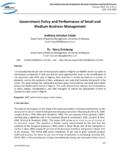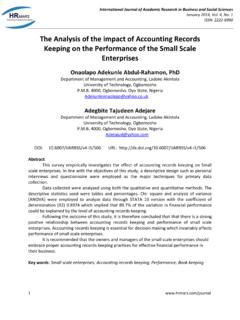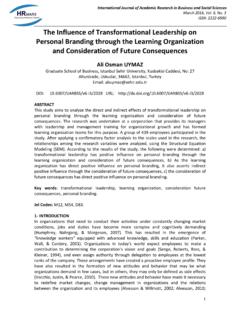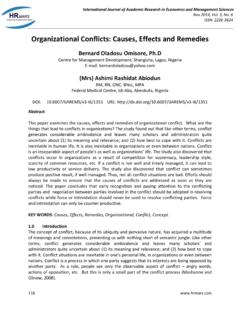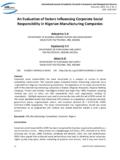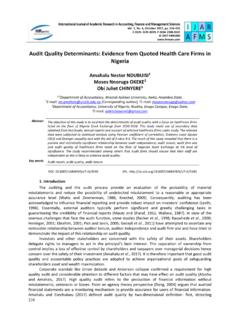Transcription of The Effects of Managers Transformational Leadership Style ...
1 International Journal of Academic Research in Accounting, Finance and Management Sciences Volume 2, Issue 1 (2012). ISSN: 2225-8329. The Effects of Managers Transformational Leadership Style on Employees Organizational Commitment Derya KARA Department of Tourism Management Education Commerce and Tourism Education Faculty Gazi University Ankara, Turkey ABSTRACT This study investigates the effect of Managers ' Transformational Leadership styles on the employees' organizational commitment in the hotel industry. The study was conducted on 443 employees in five-star hotels in Turkey.
2 First, the correlation analysis conducted between organizational commitment and Transformational Leadership styles . The results showed that there is a positive, moderate level of correlation between employee organizational commitment and Transformational Leadership styles (idealized attributes, idealized behaviors, inspirational motivation, intellectual stimulation, individual consideration). Second, multiple linear regression was applied in order to analyze the relation between organizational commitment and Managers Transformational Leadership Style . With this analysis, employees' organizational commitment and Managers Transformational Leadership styles were found to be significant KEY WORDS Transformational Leadership , employee, organizational commitment, hotel industry JEL CODES M19, M54.
3 1. Introduction Labor intensive industries, like hospitality, are dependent on the performance of its employees. Management in the hospitality industry should be more alert to interpersonal dimensions and should be more democratic and participative (Masry, Kattara,& Demerdash, 2004). Hospitality operations, like any other business, have to accept the importance of Leadership and integrate the needs of employees into their organization. It is through Leadership and understanding of this integration that will enhance the success of a hospitality operation over the long run (Lim & Boger, 2005).
4 Since hospitality industry has increasingly harsh environmental demands, Leadership skills may help organizations to utilize the available human resources more effectively. To understand and promote effective Leadership may be of considerable importance in coping and dealing successfully with environmental pressures. Organizations actively consider Leadership approaches and use them to help educate Managers on the complexities of leading people may benefit (Erkutlu, 2008). Furthermore, efffective Leadership in the hospitality industry is essential in achieving financial results and realizing desired performance objectives among the employees (Maier, 2011).
5 Leaders need to manage and motivate their employees to reach their maximum potential, to be engaged, to embrace change, and to make good technical decisions (Bennett, 2009). Clark et al (2009) reported that if frontline employees are satisfied with and committed to their jobs, they share the firm's customer-oriented values, exhibit low levels of role stress, and deliver the highest 16. International Journal of Academic Research in Accounting, Finance and Management Sciences Volume 2, Issue 1 (2012). ISSN: 2225-8329. level of service quality (Clark, Hartline, & Jones, 2009). If one is satisfying one's own needs at work then the workplace is likely to be seen as a desirable place to spend time; and, one who is satisfied at work will be more committed to the workplace and will have lower turnover intention.
6 Leadership styles have been studied by the researchers and practitioners in various theoretical contexts over the years. Although the links between Leadership and organizational commitment have been examined by researchers (Avolio, Zhu, Koh& Bhatia, 2004;. Bateman&Strasser, 1984; Bono&Judge, 2003; Clark, et al., 2009; Emery&Barker, 2007; Geijsel, Sleegers, Leithwood&Jantzi, 2003; Leach, 2005; Limsila&Ogunlana, 2008; Lok&Crawford, 1999;. Lowe&Kroeck, 1996; Mathieu&Zajac, 1990; Walumbwa&Lawler, 2003), there have been limited amounts of research conducted in the hospitality sector.
7 Therefore, the purpose of this study is to determine the Effects of Transformational Leadership Style on employees' organizational commitment in the hospitality sector. The contribution of the present study is twofold. First, it provides theoretical literature with respect to Transformational Leadership and organizational commitment. And second, because it has been done in the hospitality sector, the result of the study can provide rich information to the leaders in the hospitality sector to improve their employees' organizational commitment. 2. Transformational Leadership Style and Organizational Commitment Leadership is important to consider in relation to acceptance of innovations and to work attitudes, perceptions, behavior, service quality, and client outcomes (Aarons, 2006).
8 Leadership is vitally concerned with what people are thinking and feeling and how they are to be linked to the environment of their job/task (Nicholls, 1988). Bennett (2009) reported that organizations have to be more flexible, more nimble and more adept than ever before. Leaders need to not only be involved in the day-to-day activities of their company but they must also effectively provide vision that will lead, inspire, and motivate employees. This vision will be necessary to help others embrace change, create new products, improve processes, lower costs, and be more competitive in a global economy (Bennett, 2009).
9 In literature, many of the leaders voiced a concern for creating a clear vision for their company and stated that developing an internal environment enhances employee effectiveness, which was of primary importance (Tracey&Hinkin, 1994). Leaders were encouraged to empower their subordinates by developing them into high commitment individuals and to be team focused on quality, service, cost-effectiveness, and quantity of output of production (Bass, 1999). Clark et al. (2009) reported that a Managers Leadership Style has a tremendous influence on employees' behavior, including their adoption of the firm's strategic and marketing initiatives, particularly those relating to customer service (Clark, et al.)
10 , 2009). A major determinant of an employee's attitude is his/her perception of their immediate supervisor. As such, it seems reasonable to assume that some Leadership styles may be more effective than others at gaining the commitment of employees (Emery&Barker, 2007). Burns (1978) was one of the first to conceptualize Leadership styles as transactional and Transformational characteristics (Burns, 1978). Bass (1990) labeled Leadership styles as transactional and Transformational and measured Leadership styles by developing the Multifactor Leadership Questionnaire (MLQ) (Bass, 1990).

